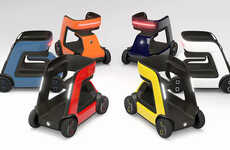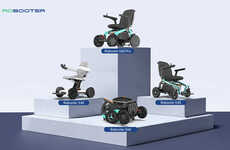
Leaning Wheelchair Design Reduces Effort and Enhances Mobility
Georgia Wray Norsten — November 6, 2024 — Eco
References: core77
A new leaning wheelchair design from ETH Zurich researchers Reto Togni and Stefan Villiger promises to revolutionize how manual wheelchair users navigate everyday environments. Addressing the physical strain often experienced while steering, particularly on sloped surfaces, this innovative leaning wheelchair significantly reduces energy demands and minimizes user injury risks.
Traditional wheelchairs require constant steering corrections, straining shoulders and increasing the risk of long-term injury. Togni and Villiger’s prototype addresses these challenges using a “steering mode” where the front wheels lock into a straight position. Users can simply lean to steer instead of using their hands for constant adjustments, as the backrest is linked to the rear wheels. Testing showed that participants required much less energy and moved faster than with conventional wheelchairs, defying expectations that higher speeds would demand more effort.
Additional health benefits include improved blood flow, relief from pressure marks, and a free hand for carrying items. Despite regulatory hurdles, the team aims for a market release by 2027, offering a user-centric approach to wheelchair mobility.
Traditional wheelchairs require constant steering corrections, straining shoulders and increasing the risk of long-term injury. Togni and Villiger’s prototype addresses these challenges using a “steering mode” where the front wheels lock into a straight position. Users can simply lean to steer instead of using their hands for constant adjustments, as the backrest is linked to the rear wheels. Testing showed that participants required much less energy and moved faster than with conventional wheelchairs, defying expectations that higher speeds would demand more effort.
Additional health benefits include improved blood flow, relief from pressure marks, and a free hand for carrying items. Despite regulatory hurdles, the team aims for a market release by 2027, offering a user-centric approach to wheelchair mobility.
Trend Themes
1. Energy-efficient Mobility Devices - Mobility devices that reduce physical strain and increase efficiency offer a new standard in user ease and environmental impact.
2. Adaptive Steering Technologies - Innovations in steering mechanisms, such as leaning-based systems, provide enhanced maneuverability and autonomy for users.
3. User-centric Health Solutions - Health-focused designs that incorporate ergonomic benefits drive the development of products improving user well-being and functionality.
Industry Implications
1. Medical Devices - The medical device industry is seeing substantial advancements through ergonomic and user-friendly innovations, transforming patient care.
2. Assistive Technology - Assistive technology manufacturers are creating products that significantly enhance the independence and quality of life for individuals with mobility challenges.
3. Rehabilitation Equipment - Rehabilitation equipment is evolving with designs that minimize physical effort and promote quicker recovery and better health outcomes.
9.2
Score
Popularity
Activity
Freshness























